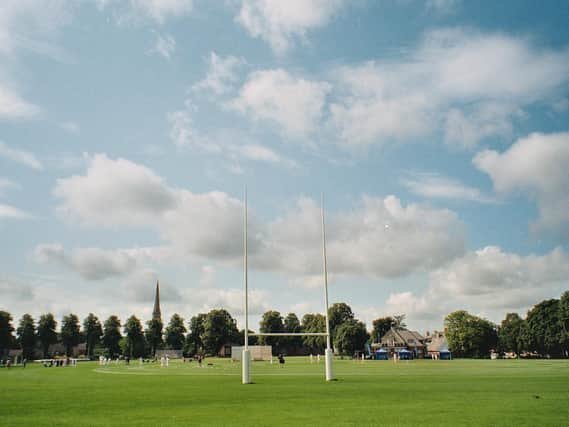Former Advertiser reporter investigates legend of Butler's Leap, proposing a new theory


The most central town in England, Rugby can stake quite a few claims to fame on the world stage.
Rupert Brooke, Lawrence Sheriff, that strange game with the funny- shaped ball… a schoolboy by the name of Butler. Butler?
Advertisement
Hide AdAdvertisement
Hide AdYes, that’s right. As in Butler’s Leap, to be found where Clifton Road goes over the little brook down in the dip.
I’ve recently been trying to find out more about the Butler boy, who is said to have amazed his Rugby School chums by leaping over the stream in 1849, and thereby immortalising not only his name, but also the location as well.
Not only that, but there is even a hostelry called The Butler’s Leap and a street of that name, uniquely the only one in Britain.
But just who was Butler… and did he really attend Rugby School? Perhaps not, as it turns out. For it may actually have been Shrewsbury School instead.
Advertisement
Hide AdAdvertisement
Hide AdI have discovered a report titled Young Sam Butler and the origins of modern running: His Athletic and Illicit Exploits as a Fox and a Hound.
This took the form of a talk by Roger Robinson, which was the final item in A Celebration of the Samuel Butler Project, at St John’s College, Cambridge, on May 11, 2012.
And this is what it said. “The invention of cross-country running as an organised modern sport has always been attributed to Rugby School, mainly because of the paper-chase ‘Hare and Hounds’ run in Thomas Hughes’s Tom Brown’s Schooldays.
“That chapter inspired the first adult running club, Thames Hare and Hounds, founded at Roehampton in 1868. Their founder, Walter Rye, paid tribute to Rugby School as the cradle of the sport in his seminal essay Paper-Chasing and Cross-Country Running for the Badminton Library in 1887.
Advertisement
Hide AdAdvertisement
Hide Ad“A game called ‘Hunt the Fox’ or ‘Hunt the Hare’ had been played in English schools at least since the reign of Queen Elizabeth I. Both names are given in Strutt’s Sports and Pastimes of the People of England.
“Shakespeare may have played it at Stratford Grammar School, as when Hamlet is eluding the Elsinore security guards, he calls out, ‘Hide, fox, and all after.’
Probably a form of hide-and-seek, the game became more mobile and more organised in some schools a little after 1800.”
The talk goes on to relate that at Shrewsbury they called it ‘The Hunt’ or ‘The Hounds.’ It was a way for the young gents to practise their future adult pastime of hunting.
Advertisement
Hide AdAdvertisement
Hide AdTwo runners called ‘foxes’ - at Rugby and elsewhere they were ‘hares’ - ran ahead laying a ‘scent’ of shredded paper, which they carried in ‘scent bags.’
As you can see, there was a lot of terminology that went with this sport.
After ‘law’, an interval of about five to ten minutes, the ‘pack’ was ‘coupled up’ and ‘threw off’ after the scent.
Cross-country was originally called paper-chasing, and many courses followed trails of paper until well into the 20th century. Hash House Harriers preserve the old game, these days following a scent of flour.
Advertisement
Hide AdAdvertisement
Hide AdGroups of runners are still called a ‘pack’ (like the original pack of hounds), the ones in front are ‘leaders,’ those who get dropped are ‘back
of the pack’ or ‘stragglers,’ and all cross-country runners are ‘harriers,’ which means ‘hare-hunters.’
Robinson continues: “The cross-over is clear in the names of the earliest running clubs, names like Thames Hare and Hounds, Cheshire Tally-ho!, Blackheath Harriers, and Essex Beagles.
“Relations with local farmers, and often with the school authorities, were less than harmonious. At some farms they were served refreshments, but at others, the Hound Books record ‘altercations,’ ‘threats,’ and ‘burning execrations’.”
Advertisement
Hide AdAdvertisement
Hide AdNevertheless, they bore no grudges, although one infuriated old man threatened ‘a summunds’ against them.
Rugby’s ‘The Crick,’ is generally cited as the earliest cross-country race, dating from 1838, four years later than Shrewsbury’s first recorded ‘Steeplechase.’
By later in the century, most public schools held steeplechases or cross-country championships.
In 1887, Lord Alfred Douglas wrote an essay called Winning the Steeplechase at Winchester, in which the first sentence is “The happiest day of my life was the day I won the school
steeplechase.”
Advertisement
Hide AdAdvertisement
Hide AdDouglas also revealed that when a bout of flu prevented him from defending his title in his final year he felt that he “Never suffered more inhis mind than I did then”, an extraordinary statement from a man who was so reviled for his involvement with Oscar Wilde.
It appears that Samuel Butler was a versatile writer, and radical thinker.
As far as his schooldays were concerned, he always claimed they had been unhappy and unsuccessful.
But all this presents a historical hiccup, as this particular Butler went to Shrewsbury, not Rugby School.
Advertisement
Hide AdAdvertisement
Hide AdThe timing is right, though. He was at Shrewsbury between 1848 to 1854, which means he could well have been running, say ‘The Crick’ or similar, and halfway along the route made his famous leap across Clifton Brook.
So was this the very same Butler who performed the legendary feat? The mystery remains.
John Phillpott’s book Go and Make the Tea, Boy, about his days on the Rugby Advertiser, is available online and from bookshops.